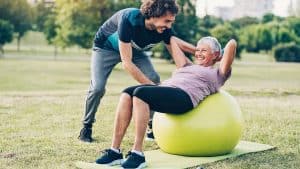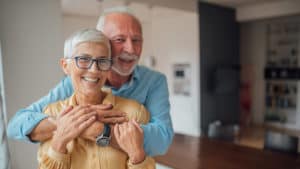How to Use Self-Massage to Improve Your Happiness After 60 – 3 Ways to Get Started

There are so many benefits of massage for everyone, and, particularly as we age, we need to think about giving our bodies and joints a bit more care than in our younger years. It’s not just about looking after our bodies. We also need to do things to improve our well-being and ensure we are caring for our minds and happiness as well.
Everyone Can Benefit from Self-Massage
In a perfect world, we would all go for a massage once a week and feel fantastic, but, unfortunately this is often not possible. There are alternatives though and, while it’s not quite as relaxing to give yourself a massage, it can still be extremely beneficial.
Even if you just allow yourself 10 minutes to massage out your shoulders or arms and hands it can significantly decrease pain, improve mobility, mood and overall well-being.
For those that experience pain in their joints or headache type pain a small amount of massage to the area each day can help increase circulation and relax tension in these areas.
There are a few ways you can apply massage to yourself, including the following 3, which I use frequently.
Using Hands and Forearms
You can use your hands and forearms to massage areas such as your hands, arms, legs, feet, face and neck.
Apply a small amount of oil to your hands or forearms and massage into the area you want to target. For example, on your arms, you can use your opposite hand to massage up the muscles to your elbow.
Use your thumbs, especially, to move across the muscle fibres and break up any adhesions. Pick up the muscle fibres between your thumb and fingers (like a pinching action) and massage the muscle this way. If you prefer a deeper pressure, make a fist and use your flattened knuckle area to apply the pressure.
If you have painful joints in your hands, using them to massage is probably not the best option as this could worsen the pain. In this case, use your forearm and move down the opposite forearm both front and back and use your elbow as you would your thumb.
You can even massage into the palm area gently, using circular motions with your elbow. The same techniques can be used on your legs and feet. Use your forearms for the larger areas such as the thigh.
To ease neck tension, gently apply pressure with your fingers in the ditch along your spine. Run your fingers up the neck into the back of the head. There is often a lot of tension held in the muscles at the top of the neck which cause headaches. It is important not to massage directly on the spine or the side of the neck where you may hit nerves.
Massage Aids
For harder to reach places such as your back and shoulders, unless you are a contortionist, there is no way you will be able to self-massage these with your hands.
This is where massage aids come into play. These are also really helpful for those suffering from ailments such as arthritis, when using your hands might not be an option. Using aids, you can easily lie on the floor, use them up against a wall or apply directly to the area and roll with your opposite hand.
Using a simple item, like a tennis ball, is often sufficient, but, personally, I like something a little firmer – like a spiky massage ball.
Stand against a wall with the ball between the wall and your back or shoulders. Roll gently across or up and down the wall moving the ball where you want to massage. If you feel any areas that feel particularly tight or painful you can pause on these with the ball and hold for a few seconds then release. You can even do the tops of your arms and chest once you get the hang of using the ball.
Foam rollers can be used in a similar way to cover broader areas. Rollers are great for self-massaging into the hips and leg areas. Be sure to start off with a softer type roller as the harder they are it can be a little painful. But, this also depends on how much pressure you apply down onto the roller.
I have heard of people utilizing their pool noodles for this type of activity. You can see some of the types of actions that can be performed on a roller here.
Stretching and Heat
Whilst this isn’t technical a “massage,” stretching can do wonders when it comes to releasing built up tension. It is also very helpful in reinforcing relaxation, post massage, as well as, helping you to de-stress.
Always ensure stretching is done within your limits (a slight stretch with no pain) and in a controlled way. NO bouncing!
After massaging, make sure to gently stretch the area and hold for at least 30 seconds (repeat at least 3 times). You can then apply some heat, such as a wheat bag, or hot towel compress, to the area. The other option for applying heat is to stand under the hot shower for a few minutes and let the running water give you a massage.
There are many reasons to believe that massage can assist in greatly improving your happiness too! For starters, reducing pain in your muscles and joints is bound to make you feel happier.
Applied regularly (even by yourself), you are helping to improve your circulation, both to the muscles and to the skin, which along with the application of oils, can help improve the appearance of the skin.
Finally, the feeling of touch and warmth help to release endorphins from the brain and many studies have shown that regular massage significantly improves mood and reduces stress and anxiety.
Have you applied self-massage? How has it helped and how did it make you feel? Please join the conversation.
Read More





